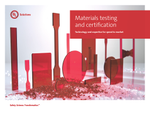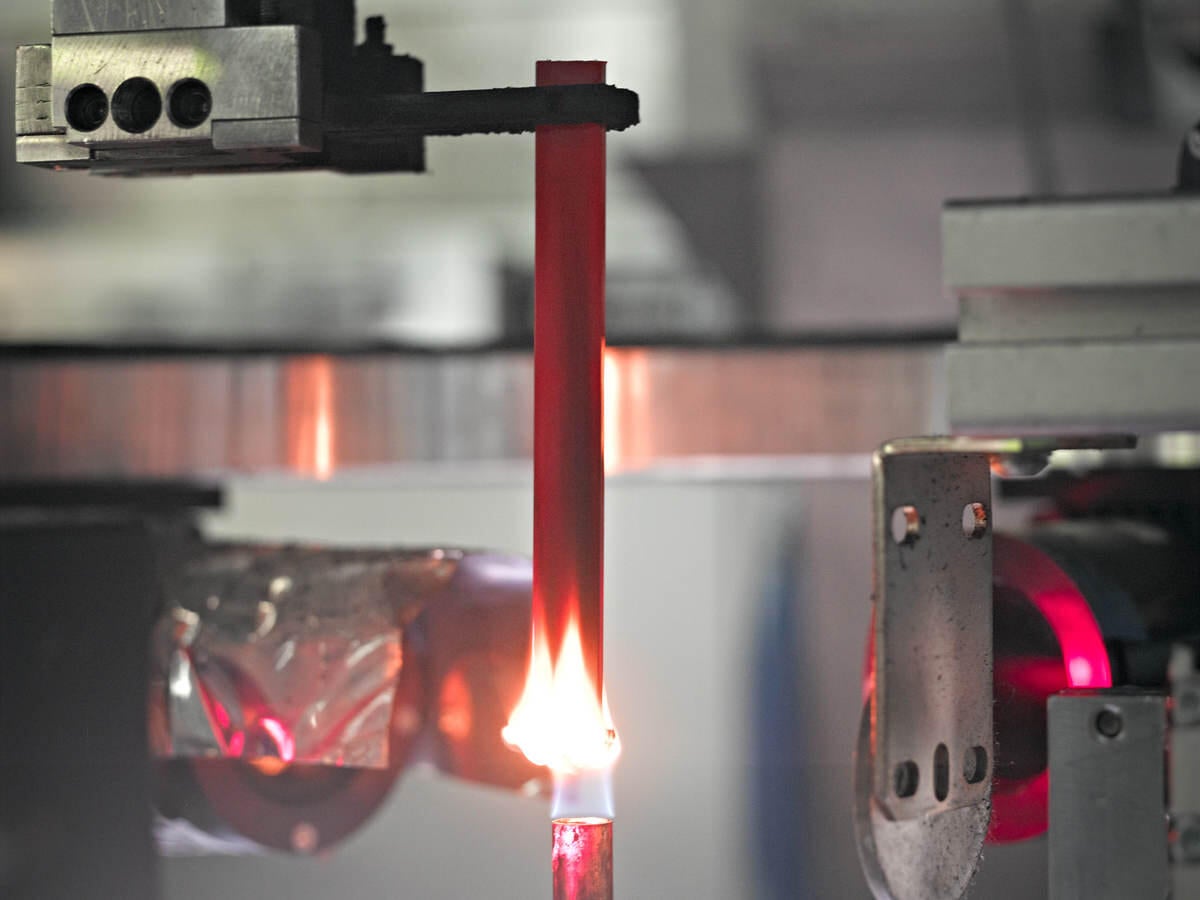
UL Materials Testing and Certification (English)
Our UL Solutions testing facilities can carry out the following combustion (fire) tests for you.

There are two preselection test programs conducted on plastic materials to measure flammability characteristics. The first program determines the material’s tendency to either extinguish or spread the flame once the specimen has been ignited.
The second program measures the ignition resistance of the plastic to electrical ignition sources. The material’s resistance to ignition and surface tracking characteristics is described in UL 746A, which is similar to the test procedures described in IEC 60112, 60695 and 60950.
There are 12 UL 94 specified flame classifications assigned to materials based on the results of these small-scale flame tests. These classifications, listed in descending order for each of the following three groupings, are used to distinguish a material’s burning characteristics after test specimens have been exposed to a specified test flame under controlled laboratory conditions.
Specimens molded from the plastic material are oriented in either a horizontal or vertical position depending on the specifications of the relevant test method. They are then subjected to a defined flame ignition source for a specified period of time. In some tests, the test flame is only applied once — as is the case in the horizontal burning (HB) test — while the flame is applied at least twice in other tests.
An HB flame rating indicates that the material was tested in a horizontal position and found to burn at a rate less than a specified maximum.
The three vertical ratings — V2, V1 and V0 — indicate that the material was tested in a vertical position and self-extinguished within a specified time after the ignition source was removed. The vertical ratings also indicate whether the test specimen dripped flaming particles that ignited a cotton indicator located below the sample.
UL 94 also describes a method in which the test flame is applied for up to five applications in testing for a 5VA or 5VB classification. These small-scale tests measure the propensity of a material to extinguish or spread flames once it becomes ignited.
When looking at flame ratings for plastic materials commonly molded to fabricate enclosures and structural parts/insulators found in consumer electronic products (5VA, 5VB, V-0, V-1, V-2 and HB), a material classified as 5VA or 5VB is subjected to a flame ignition source that is approximately five times more severe than that used in the V-0, V-1, V-2 and HB tests. Also, these specimens may not drip any flaming particles. Three of the remaining six classifications specified in UL 94 relate to low-density foam materials commonly used in fabricating speaker grills and sound-deadening material (HF-1, HF-2, HBF). The remaining three classifications are assigned to thin films commonly used in flexible printed wiring boards, generally not capable of supporting themselves in a horizontal position (VTM-0, VTM-1, VTM-2). A flame rating of VTM-0 cannot be considered equivalent to a V-0 rating, as the test methods are quite different. Likewise, VTM-1 and VTM-2 cannot be considered equivalent to V-1 and V-2 respectively.
The horizontal burning test is used to determine the HB flammability rating of a material. The flammability rating is calculated for a test specimen as a function of the burning rate and taking account of the material thickness.
Standards for flammability UL 94 HB
UL 94
On request:
(IEC) DIN EN 60695-11-10A or equivalent standards
This method is used to determine the UL 94 V-0, V-1 and V-2 flammability ratings. The test evaluates both the burning and afterglow times and dripping of the burning test specimen.
Standards for flammability UL 94 V
UL 94
On request:
(IEC) DIN EN 60695-11-10B or equivalent standards
This method is used to determine the UL 94-5VA and -5VB flammability ratings.
The test evaluates both the flammability of the test specimen and any holes that are formed in sheets.
Standards for flammability UL 94 5V
UL 94
On request:
(IEC) DIN EN 60695-11-20 or equivalent standards
This method is used to determine the UL 94 VTM-0, VTM-1 and VTM-2 flammability ratings of thin materials. Failure to pass the UL 94 V test is a precondition of all VTM ratings.
The test evaluates both the burning and afterglow times and dripping of the burning test specimen.
Standards for flammability UL 94 VTM
UL 94 or equivalent standards
The horizontal burning test on foamed materials is used to determine the UL 94-HBF, HF-1 and HF-2 flammability ratings taking account of the calculated density.
Standards for flammability UL 94 HBF
UL 94 or equivalent standards
Pre-treatment:
48 hours / 23°C / relative humidity
| Flame application | 20 mm high Tirill burner flame |
| Flame application time | 30 s |
If the flame front reaches the first mark within 30 s, flame application is discontinued.
| Test criteria | Burning rate in V | Flammability rating |
|---|---|---|
| Test specimen thickness 3 - 13 mm | ≤ 40 mm/min | HB |
| Test specimen thickness ‹ 3 mm | ≤ 75 mm/min | HB |
| Flame is extinguished before first mark | = 0 mm/min | HB |
Pre-treatment:
2 days / 23 °C / 50 % relative humidity
7 days / 70 °C / hot air oven
| Flame height | 20 mm |
| Flame application time | 2 x 10 s |
| The second flame application time begins as soon as the first burning time ends |
| Flammability rating UL 94 V | |||
|---|---|---|---|
| Test criteria | V-0 | V-1 | V-2 |
| Burning time of each individual test specimen (s) (after first and second flame applications) |
≤10 | ≤30 | ≤30 |
| Total burning time (s) (10 flame applications) |
≤50 | ≤250 | ≤250 |
| Burning and afterglow times after second flame application (s) | ≤30 | ≤60 | ≤60 |
| Dripping of burning specimens (ignition of cotton batting) |
no | no | yes |
| Combustion up to holding clamp (specimens completely burned) |
no | no | no |
Pre-treatment:
2 days / 23 °C / 50 % relative humidity.
7 days / 70 °C / hot air oven
| Flammability rating UL 94 | ||
|---|---|---|
| Test criteria (test specimens) | 5 VA | 5 VB |
| Burning and afterglow times of specimens after fifth flame application (s) | ≤60 | ≤60 |
| Dripping of burning specimens | no | no |
| Hole formation | no | yes |
Pre-treatment:
2 days / 23 °C / 50 % relative humidity
7 days / 70 °C / hot air oven
| Flame height | 20 mm |
| Flame application time | 2 x 3 s |
| The second flame application time begins as soon as the first burning time ends |
| Flammability rating UL 94 VTM | |||
|---|---|---|---|
| Test criteria | VTM-0 | VTM-1 | VTM-2 |
| Burning time of each individual test specimen (s) (after first and second flame applications) |
≤ 10 | ≤ 30 | ≤ 30 |
| Total burning time (s) (10 flame applications) |
≤ 50 | ≤ 250 | ≤ 250 |
| Burning and afterglow times after second flame application (s) | ≤ 30 | ≤ 60 | ≤ 60 |
| Dripping of burning specimens (ignition of cotton batting) | no | no | yes |
| Combustion up to holding clamp (specimens completely burned) | no | no | no |
Vorbehandlung:
2 days / 23 °C / 50 % relative humidity.
7 days / 70 °C / hot air oven
| Flame height | 38 mm |
| Flame application time | 60 s |
| Flammability rating UL 94 HBF | ||
|---|---|---|
| Test criteria (test specimens) | HF-1 | HF-2 |
| Burning time (s) | 4/5 ≤ 2 1/5 ≤ 10 |
4/5 ≤ 2 1/5 ≤ 10 |
| Burning and afterglow times of each individual specimen (s) | ≤ 30 | ≤ 30 |
| Dripping of burning specimens (ignition of cotton batting) |
no | yes |
| Damaged length of each individual specimen (mm) | < 60 | < 60 |
Criteria for HBF ratings

UL Materials Testing and Certification (English)
Thanks for your interest in our products and services. Let's collect some information so we can connect you with the right person.